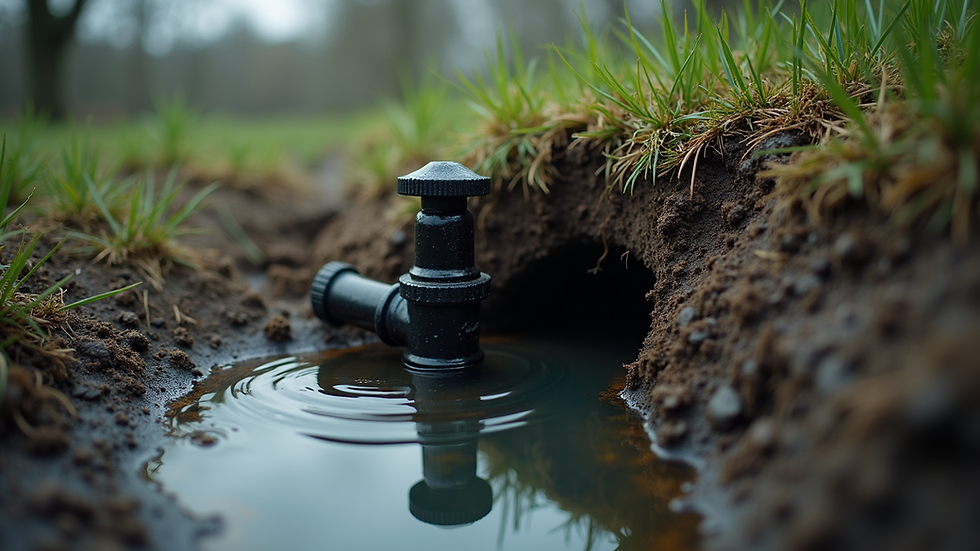Understanding the Process of Septic System Installation
- 509excavate
- Jun 16
- 4 min read
Moving to a home with a septic system can be daunting, especially if you're unfamiliar with how they work. A septic system is a type of onsite sewage facility used to treat wastewater. Understanding the process of septic system installation can help you make informed decisions for your new home. This blog post will guide you through the critical steps involved in installing a septic system, helping ensure a long-lasting and effective waste management solution for your property.
What is a Septic System?
A septic system is an underground sewage treatment structure commonly found in rural areas without centralized sewer systems. It consists of a septic tank, which separates solids and liquids, and a drain field that disperses effluent into the soil. The soil helps to treat the effluent, filtering out harmful bacteria and nutrients.
Components of a Septic System
The main components of a septic system include:
Septic Tank: This is the first step in wastewater treatment. It holds the sewage and allows solids to settle at the bottom, while the liquid effluent flows to the drain field.
Drain Field: The effluent from the septic tank is channeled into the drain field, where it gets absorbed into the surrounding soil. This process naturally filters and treats the water before it re-enters the groundwater.
Soil: The type of soil on your property significantly impacts the efficacy of your septic system. Sandy soils drain quickly, while clay soils retain water, which can cause slow absorption.

The Importance of Proper Septic System Installation
Proper septic system installation is crucial for several reasons. First, a malfunctioning septic system can lead to groundwater contamination, posing a health risk to you and your neighbors. Second, an improperly installed system can result in costly repairs down the line. Ensuring the system is installed correctly from the start can save you time and money.
Steps Involved in Septic System Installation
1. Site Assessment
Before installation, a thorough site assessment must be conducted. This can involve soil testing to determine the soil's percolation rate, which indicates how quickly water moves through the soil. The assessment will help determine the right type of septic system for your property and whether it is compatible with local regulations.
2. Designing the Septic System
Once the site assessment is complete, the next step is designing the septic system. A professional will create a blueprint for your system, indicating where the septic tank and drain field will be located. Factors like the number of bedrooms in your home and the types of soil will influence the system's design.

3. Obtaining Permits
Before you can install a septic system, you'll need to secure the necessary permits from your local health department or environmental agency. Regulations vary by location, so it is essential to check your area's requirements. These permits ensure that the installation adheres to local codes and protects the environment.
4. Excavation and Installation
After obtaining the permits, excavation of the site begins. This step involves digging trenches for the septic tank and the drain field. The tank is typically installed underground, and pipes are laid out to connect the house to the tank and the tank to the drain field.
5. Backfilling and Soil Replacement
Once the septic tank and drain field pipes are in place, the trenches are backfilled with soil. It's important to replace the soil carefully to avoid air pockets, which can hinder the system's functionality.
6. Final Inspection
After installation, a final inspection is usually required. A local inspector will check the system to ensure it meets the necessary standards and regulations. Once it passes inspection, you can begin using the system.

Maintenance of Your Septic System
Once your septic system is installed, it’s vital to maintain it properly to ensure its longevity and efficiency. Here are some best practices for septic system maintenance:
Regular Pumping: It's recommended to pump your septic tank every 3-5 years, depending on your household size and usage. Regular pumping removes accumulated solids and prevents clogs.
Water Conservation: Reduce water usage in your home. Excessive water can overwhelm your septic system, leading to failures. Simple changes, like fixing leaks and using low-flow fixtures, can help.
Avoid Harsh Chemicals: Do not flush harmful chemicals down your drains. These substances can disrupt the balance of bacteria essential for your septic system's function.
Monitor the Drain Field: Keep an eye on your drain field for signs of trouble, such as pooling water or a foul odor. If you notice these signs, contact a professional immediately.
Key Takeaways
Installing a septic system involves several critical steps, from site assessments to final inspections. Understanding each phase of the installation process will help you make informed choices to ensure your system operates efficiently. Proper maintenance is also crucial to prolong the life of your septic system and prevent costly repairs.
By knowing what to expect during septic system installation, you can ensure your new home is equipped with a safe and effective wastewater management solution. For more information on septic system options and professional installation services, consider visiting septic system installation services.
Final Thoughts on Septic Systems
Having a septic system may seem complex, but with the right information and guidance, it doesn't have to be intimidating. Whether you’re building a new home or retrofitting an existing property, a well-installed and maintained septic system can serve you well for many years. By understanding the process, you’ll be better equipped to manage this vital component of your home.




Comments